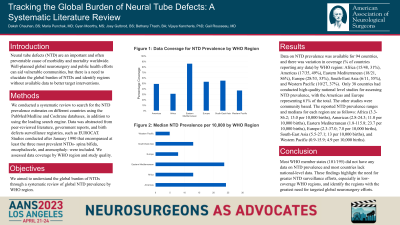Tracking the Global Birth Prevalence of Neural Tube Defects: A Comprehensive Literature Review
Friday, April 21, 2023


Daksh Chauhan, BS (he/him/his)
Medical Student
Perelman School of Medicine at the University of Pennsylvania
Philadelphia, Pennsylvania, United States
ePoster Presenter(s)
Introduction: Neural tube defects (NTD) are an important and often preventable cause of morbidity and mortality worldwide. Global neurosurgical and public health efforts, such as folic acid fortification, can alleviate the disease burden in vulnerable communities, but time and resource constraints demand better characterization of that burden.
Methods: We conducted a comprehensive review of NTD prevalence estimates in different countries using the PubMed/Medline and Cochrane databases. Prevalence estimates were abstracted from peer-reviewed literature, government reports, and birth defects surveillance registries like EUROCAT. Studies conducted after January 1990 that encompassed at least spina bifida, encephalocele, and anencephaly were included. We assessed data coverage by WHO region and study quality.
Results: NTD prevalence was available for 48% of assessed countries (94/195), and there was variation by WHO region: Africa (15/48, 31%), Americas (17/35, 49%), Eastern Mediterranean (18/21, 86%), Europe (28/53, 53%), South-East Asia (6/11, 55%), and Western Pacific (10/27, 37%). Not all countries in Europe reported NTD prevalence data freely in the EUROCAT registry so some estimates are missing for European countries. Only 19.5% of all countries (38/195) had high-quality national-level studies assessing NTD prevalence, with the Americas and Europe representing 61% of all conducted national studies. The reported NTD prevalence ranges and medians for each region are as follows: Africa (3.3-86.2; 13.0 per 10,000 births), Americas (2.8-24.3; 11.0 per 10,000 births), Eastern Mediterranean (1.8-115.8; 23.7 per 10,000 births), Europe (2.3-37.0; 7.8 per 10,000 births), South-East Asia (5.5-27.1; 13 per 10,000 births), and Western Pacific (0.9-15.9; 4.9 per 10,000 births).
Conclusion : For most WHO member states, there is no available NTD prevalence data, and for most countries, there is no national-level data. These findings highlight the need for greater NTD surveillance efforts, especially in WHO regions with little available data, and to identify the regions with the greatest need for targeted global neurosurgery efforts.
Methods: We conducted a comprehensive review of NTD prevalence estimates in different countries using the PubMed/Medline and Cochrane databases. Prevalence estimates were abstracted from peer-reviewed literature, government reports, and birth defects surveillance registries like EUROCAT. Studies conducted after January 1990 that encompassed at least spina bifida, encephalocele, and anencephaly were included. We assessed data coverage by WHO region and study quality.
Results: NTD prevalence was available for 48% of assessed countries (94/195), and there was variation by WHO region: Africa (15/48, 31%), Americas (17/35, 49%), Eastern Mediterranean (18/21, 86%), Europe (28/53, 53%), South-East Asia (6/11, 55%), and Western Pacific (10/27, 37%). Not all countries in Europe reported NTD prevalence data freely in the EUROCAT registry so some estimates are missing for European countries. Only 19.5% of all countries (38/195) had high-quality national-level studies assessing NTD prevalence, with the Americas and Europe representing 61% of all conducted national studies. The reported NTD prevalence ranges and medians for each region are as follows: Africa (3.3-86.2; 13.0 per 10,000 births), Americas (2.8-24.3; 11.0 per 10,000 births), Eastern Mediterranean (1.8-115.8; 23.7 per 10,000 births), Europe (2.3-37.0; 7.8 per 10,000 births), South-East Asia (5.5-27.1; 13 per 10,000 births), and Western Pacific (0.9-15.9; 4.9 per 10,000 births).
Conclusion : For most WHO member states, there is no available NTD prevalence data, and for most countries, there is no national-level data. These findings highlight the need for greater NTD surveillance efforts, especially in WHO regions with little available data, and to identify the regions with the greatest need for targeted global neurosurgery efforts.
